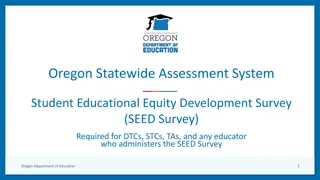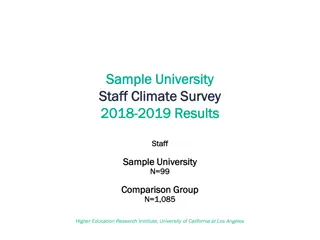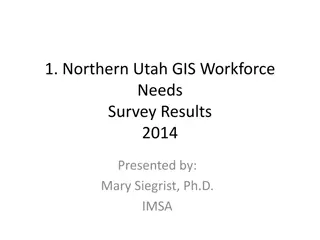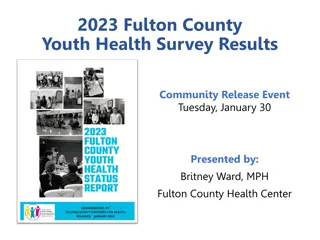Insights from Multi-Day Forecast Long Lead Time Survey Results
Southwest Power Pool (SPP) conducted a survey to assess the impact of a multi-day commitment process on long lead-time resources. Results showed varying preferences among members for different commitment statuses, with considerations for market, self, and reliability commitments. Environmental restrictions and the use of opportunity cost adders were also discussed in relation to self-commitment. The survey aimed to provide insights into the potential development of a Multi-Day Commitment Market and aid SPP in designing optimal commitment processes.
Download Presentation

Please find below an Image/Link to download the presentation.
The content on the website is provided AS IS for your information and personal use only. It may not be sold, licensed, or shared on other websites without obtaining consent from the author.If you encounter any issues during the download, it is possible that the publisher has removed the file from their server.
You are allowed to download the files provided on this website for personal or commercial use, subject to the condition that they are used lawfully. All files are the property of their respective owners.
The content on the website is provided AS IS for your information and personal use only. It may not be sold, licensed, or shared on other websites without obtaining consent from the author.
E N D
Presentation Transcript
MULTI-DAY FORECAST LONG LEAD TIME SURVEY FINAL RESULTS AND SELF COMMITMENT ANALYSIS DANIEL HARLESS, MARKET DESIGN SOUTHWEST POWER POOL, INC. 1 Helping our members work together to keep the lights on... today and in the future. SPPorg southwest-power-pool SouthwestPowerPool
BACKGROUND Currently, economic unit commitments are not evaluated beyond the 24 hour period of the next operating day. SPP is working on a market design initiative that seeks to provide an economic evaluation of resources with long lead times and provide commitment instructions for these resources Presently, self-commitment is the main way long lead- time resources are committed. This survey will help us determine the impact of a multi-day commitment process to the offers of such resources. MWG discussed and requested SPP review the 2019 self-commitment instances to determine the impact that occurred on the market and to provide the results. 2
REASONS FOR SURVEY To determine the impact of a multi-day commitment process to the offers of long lead-time resources. To determine if a multi-day commitment market would alleviate the need for self-commitments. To help SPP determine the best design for a multi-day commitment process. 3
RESULTS 4
ABOUT THE SURVEY We have completed the survey. We conducted a phone survey with 21 members. The survey consisted of 4 questions. 5
Question #1 - If SPP were to develop a Multi-Day Commitment Market, please estimate the % of time you would submit the following commit status: (Market, Self, Reliability or Not Participating) The slight majority of the members offering in Market Status, with a few less offering in Self and a very small amount in Reliability. Many are not sure if they would deviate from current practices, especially not knowing what the potential design will look like. Some members believe they could better structure their offers through increased information that could be provided through a Multi-Day Market. 6
Question #2 - How many resources have any environmental or other restrictions that would necessitate the primary mode of operation being self- commitment during certain times? Several members have no environmental restrictions that impact Self commitments. A few have to Self due to testing, or to keep from cycling too often. Are opportunity Cost Adders available to make you indifferent to your commitment time period? Most members say the current opportunity cost calculator (OCC) would not help with this situation. If the resources have an environmental restriction and the restriction is state-based, does the state have a waiver process in case you have to exceed your output limitation? Most members do not have state waivers, or if they do, they do nor pursue them. In some cases, there may be a state waiver for emergencies. 7
Question #3 - Are Resource start-up times due to unit construction/operating characteristics or are there transmission limitations or other factors? Most members start-up times are due to unit construction or operating characteristics, with no transmission limits. A few members start-up times are due to other factors: Procedural (the time it takes to properly and safely bring a unit on-line), staffing, system integrity, temperature and chemical limitations. 8
Question #4 - Please provide any additional comments you think would be beneficial to this survey Variety of Feedback. Many members are concerned about the VER and Load Forecast being so far in the future. Some members were concerned about forecasting offers for resources so far in the future. Many concerned about a finically binding position so far in the future. Received feedback of the development of a Multi-Day Market 9
SELF-COMMIT INSTANCES ANALYSIS Determine how many Resources offered self at least once in 2019. Percentage of time self offered for each Resource Hourly Average Dispatch Compared to Offered Limit when Self-Committed. DAMKT vs RUC Self-Commitments 10
RESULTS 11
DAMKT VS RUC COMMITMENTS INCLUDING FORECASTED RESOURCES MONTH FORCASTED RESOURCE DAMKT SELF DAMKT MKT RUC SELF RUC MKT January February March April May June July August September October November December 57% 57% 58% 60% 57% 53% 50% 50% 54% 60% 60% 60% 24% 23% 20% 16% 16% 19% 19% 19% 18% 16% 18% 18% 17% 17% 18% 20% 24% 25% 29% 28% 25% 21% 20% 20% 1% 1% 1% 1% 1% 1% 1% 1% 1% 1% 1% 1% 2% 3% 2% 2% 2% 2% 2% 2% 3% 2% 2% 2% 12
DAMKT VS RUC SELF-COMMITTING RESOURCES MONTH DAMKT SELF DAMKT MKT RUC SELF RUC MKT January February March April May June July August September October November December 73% 72% 72% 65% 63% 62% 50% 45% 50% 66% 66% 67% 23% 25% 25% 32% 34% 35% 48% 52% 48% 30% 29% 28% 3% 2% 2% 2% 3% 2% 2% 1% 1% 2% 3% 3% 1% 1% 1% 1% 1% 1% 1% 1% 2% 2% 2% 1% 13
NUMBER OF RESOURCES SELF COMMITTING BY PERCENTAGE RTBM DAMKT Self-Commit by Resource 33 32 100% 15 11 99% - 75% 6 8 74% - 50% 26 22 49% - 25% 30 27 24% - 0% 14
2019 RTBM AVERAGE DISPATCH FOR SELF- COMMITTED RESOURCES MONTH DISPATCH MW ECOMAX ECOMIN January February March April May June July August September October November December 14,714 15,037 12,158 8,902 9,290 12,081 12,142 11,743 9,924 7,715 9,471 9,181 17,387 18,068 14,242 10,902 11,278 15,369 14,653 14,182 12,303 10,103 11,877 11,044 6,442 6,364 5,476 4,667 4,977 6,804 6,594 6,192 5,319 5,125 5,263 4,709 15
2019 DA HOURLY DISPATCH FOR SELF-COMMITTED RESOURCES MONTH DISPATCH MW ECOMAX ECOMIN January February March April May June July August September October November December 14,493 14,727 11,892 8,712 9,030 11,801 11,887 11,595 9,796 7,592 9,255 9,011 17,097 17,643 13,892 10,651 10,923 14,955 14,260 13,952 12,105 9,916 11,561 10,820 6,303 6,172 5,280 4,559 4,817 6,595 6,428 6,097 5,256 5,036 5,115 4,599 16
2019 RTBM AVERAGE HOURLY DISPATCH FOR RUC SELF-COMMITTED RESOURCES MONTH DISPATCH MW ECOMAX ECOMIN January February March April May June July August September October November December 221 310 266 190 260 280 255 148 128 122 217 171 290 426 350 251 354 414 393 230 198 187 316 224 139 192 196 108 161 209 166 96 63 89 148 110 17
IMPACT Historically in SPP s market, self-committed Resources were marginal in the DAMKT the majority of the time. Historically in SPP s market, prices are lower when at least one self-committed resource is marginal. Self-commitment of resources can lead to additional commitments to manage congestion, which can increase unused generating capacity on the system. Depending on the characteristics of self-committed resources, the market may commit additional resources to ensure rampable capability. 18
NEXT STEPS Implement Multi-Day Forecast Review Results of Multi-Day Forecast Level set and determine objectives of Multi-Day based on MDF, Grid evolution and membership needs Develop Multi-Day Market Design proposal. Present Proposal to the MWG for discussion. 19























